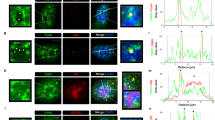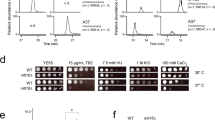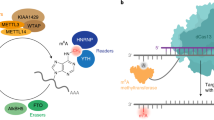Abstract
Small nuclear RNAs (snRNAs) are core spliceosome components and mediate pre-mRNA splicing. Here we show that snRNAs contain a regulated and reversible nucleotide modification causing them to exist as two different methyl isoforms, m1 and m2, reflecting the methylation state of the adenosine adjacent to the snRNA cap. We find that snRNA biogenesis involves the formation of an initial m1 isoform with a single-methylated adenosine (2′-O-methyladenosine, Am), which is then converted to a dimethylated m2 isoform (N6,2′-O-dimethyladenosine, m6Am). The relative m1 and m2 isoform levels are determined by the RNA demethylase FTO, which selectively demethylates the m2 isoform. We show FTO is inhibited by the oncometabolite d-2-hydroxyglutarate, resulting in increased m2-snRNA levels. Furthermore, cells that exhibit high m2-snRNA levels show altered patterns of alternative splicing. Together, these data reveal that FTO controls a previously unknown central step of snRNA processing involving reversible methylation, and suggest that epitranscriptomic information in snRNA may influence mRNA splicing.
This is a preview of subscription content, access via your institution
Access options
Access Nature and 54 other Nature Portfolio journals
Get Nature+, our best-value online-access subscription
$29.99 / 30 days
cancel any time
Subscribe to this journal
Receive 12 print issues and online access
$259.00 per year
only $21.58 per issue
Buy this article
- Purchase on Springer Link
- Instant access to full article PDF
Prices may be subject to local taxes which are calculated during checkout




Similar content being viewed by others
Code availability
All custom code used in this study can be obtained upon request from the corresponding author.
Data availability
Sequencing data that support the findings of this study have been deposited in the NCBI GEO database under accession number GSE107872. Other data shown in the article are available from the corresponding authors upon reasonable request.
References
Hadjiolov, A. A., Venkov, P. V. & Tsanev, R. G. Ribonucleic acids fractionation by density-gradient centrifugation and by agar gel electrophoresis: a comparison. Anal. Biochem. 17, 263–267 (1966).
Dreyfuss, G., Philipson, L. & Mattaj, I. W. Ribonucleoprotein particles in cellular processes. J. Cell. Biol. 106, 1419–1425 (1988).
Lührmann, R. Functions of U-snRNPs. Mol. Biol. Rep. 14, 183–192 (1990).
Kunkel, G. R., Maser, R. L., Calvet, J. P. & Pederson, T. U6 small nuclear RNA is transcribed by RNA polymerase III. Proc. Natl Acad. Sci. USA 83, 8575–8579 (1986).
Dahlberg, J. E. & Lund, E. Structure and expression of U-snRNA genes. Mol. Biol. Rep. 12, 139–143 (1987).
Baillat, D. et al. Integrator, a multiprotein mediator of small nuclear RNA processing, associates with the C-terminal repeat of RNA polymerase II. Cell 123, 265–276 (2005).
Cory, S. & Adams, J. M. Modified 5′-termini in small nuclear RNAs of mouse myeloma cells. Mol. Biol. Rep. 2, 287–294 (1975).
Busch, H., Reddy, R., Rothblum, L. & Choi, Y. C. SnRNAs, SnRNPs, and RNA processing. Annu. Rev. Biochem. 51, 617–654 (1982).
Mattaj, I. W. Cap trimethylation of U snRNA is cytoplasmic and dependent on U snRNP protein binding. Cell 46, 905–911 (1986).
Matera, A. G. & Wang, Z. A day in the life of the spliceosome. Nat. Rev. Mol. Cell Biol. 15, 108–121 (2014).
Pellizzoni, L. Chaperoning ribonucleoprotein biogenesis in health and disease. EMBO Rep. 8, 340–345 (2007).
Patel, S. B. & Bellini, M. The assembly of a spliceosomal small nuclear ribonucleoprotein particle. Nucleic Acids Res. 36, 6482–6493 (2008).
Shukla, S. & Parker, R. Quality control of assembly-defective U1 snRNAs by decapping and 5′-to-3′ exonucleolytic digestion. Proc. Natl Acad. Sci. USA 111, E3277–E3286 (2014).
Ishikawa, H. et al. Identification of truncated forms of U1 snRNA reveals a novel RNA degradation pathway during snRNP biogenesis. Nucleic Acids Res. 42, 2708–2724 (2014).
Karijolich, J. & Yu, Y. T. Spliceosomal snRNA modifications and their function. RNA Biol. 7, 192–204 (2010).
Pendleton, K. E. et al. The U6 snRNA m6A methyltransferase METTL16 regulates SAM synthetase intron retention. Cell 169, 824–835.e14 (2017).
Jia, G. et al. N 6-Methyladenosine in nuclear RNA is a major substrate of the obesity-associated FTO. Nat. Chem. Biol. 7, 885–887 (2011).
Jia, G. et al. Oxidative demethylation of 3-methylthymine and 3-methyluracil in single-stranded DNA and RNA by mouse and human FTO. FEBS Lett. 582, 3313–3319 (2008).
Mauer, J. et al. Reversible methylation of m6Am in the 5′ cap controls mRNA stability. Nature 541, 371–375 (2017).
Wei, C., Gershowitz, A. & Moss, B. N6,O2′-Dimethyladenosine a novel methylated ribonucleoside next to the 5′ terminal of animal cell and virus mRNAs. Nature 257, 251–253 (1975).
Kruse, S. et al. A novel synthesis and detection method for cap-associated adenosine modifications in mouse mRNA. Sci. Rep. 1, 126 (2011).
Hess, M. E. et al. The fat mass and obesity associated gene (Fto) regulates activity of the dopaminergic midbrain circuitry. Nat. Neurosci. 16, 1042–10489 (2013).
Reddy, R., Henning, D., Epstein, P. & Busch, H. Primary and secondary structure of U2 snRNA. Nucleic Acids Res. 9, 5645–5658 (1981).
Linder, B. et al. Single-nucleotide-resolution mapping of m6A and m6Am throughout the transcriptome. Nat. Methods 12, 767–772 (2015).
Fischer, J. et al. Inactivation of the Fto gene protects from obesity. Nature 458, 894–898 (2009).
Mowry, K. L. & Steitz, J. A. Identification of the human U7 snRNP as one of several factors involved in the 3′ end maturation of histone premessenger RNA’s. Science 238, 1682–1687 (1987).
Jawdekar, G. W. & Henry, R. W. Transcriptional regulation of human small nuclear RNA genes. Biochim. Biophys. Acta 1779, 295–305 (2008).
Bohnsack, M. T. & Sloan, K. E. Modifications in small nuclear RNAs and their roles in spliceosome assembly and function. Biol. Chem. 399, 1265–1276 (2018).
Wei, J. et al. Differential m6A, m6Am, and m1A demethylation mediated by FTO in the cell nucleus and cytoplasm. Mol. Cell 71, 973–985.e5 (2018).
Hogeweg, P. & Konings, D. A. U1 snRNA: the evolution of its primary and secondary structure. J. Mol. Evol. 21, 323–333 (1984–1985).
Bringmann, P. & Luhrmann, R. Antibodies specific for N6-methyladenosine react with intact snRNPs U2 and U4/U6. FEBS Lett. 213, 309–315 (1987).
Yang, Y. et al. UOK 262 cell line, fumarate hydratase deficient (FH-/FH-) hereditary leiomyomatosis renal cell carcinoma: in vitro and in vivo model of an aberrant energy metabolic pathway in human cancer. Cancer Genet. Cytogenet. 196, 45–55 (2010).
Gerken, T. et al. The obesity-associated FTO gene encodes a 2-oxoglutarate-dependent nucleic acid demethylase. Science 318, 1469–1472 (2007).
Aik, W. et al. Structural basis for inhibition of the fat mass and obesity associated protein (FTO). J. Med. Chem. 56, 3680–3688 (2013).
Ward, P. S. et al. The common feature of leukemia-associated IDH1 and IDH2 mutations is a neomorphic enzyme activity converting α-ketoglutarate to 2-hydroxyglutarate. Cancer Cell. 17, 225–234 (2010).
Wang, F. et al. Targeted inhibition of mutant IDH2 in leukemia cells induces cellular differentiation. Science 340, 622–626 (2013).
Rohle, D. et al. An inhibitor of mutant IDH1 delays growth and promotes differentiation of glioma cells. Science 340, 626–630 (2013).
Bennett Saidu, N. E. et al. Dimethyl fumarate is highly cytotoxic in KRAS mutated cancer cells but spares non-tumorigenic cells. Oncotarget 9, 9088–9099 (2018).
Gabanella, F. et al. Ribonucleoprotein assembly defects correlate with spinal muscular atrophy severity and preferentially affect a subset of spliceosomal snRNPs. PLoS One 2, e921 (2007).
Lotti, F. et al. An SMN-dependent U12 splicing event essential for motor circuit function. Cell 151, 440–454 (2012).
Zhao, X. et al. FTO-dependent demethylation of N6-methyladenosine regulates mRNA splicing and is required for adipogenesis. Cell Res. 24, 1403–1419 (2014).
Bartosovic, M. et al. N6-methyladenosine demethylase FTO targets pre-mRNAs and regulates alternative splicing and 3′-end processing. Nucleic Acids Res. 45, 11356–11370 (2017).
Wei, J. et al. Differential m6A, m6Am, and m1A demethylation mediated by FTO in the cell nucleus and cytoplasm. Mol. Cell 71, 973–985.e975 (2018).
Su, R. et al. R-2HG exhibits anti-tumor activity by targeting FTO/m6A/MYC/CEBPA Signaling. Cell 172, 90–105.e123 (2018).
Ke, S. et al. m6A mRNA modifications are deposited in nascent pre-mRNA and are not required for splicing but do specify cytoplasmic turnover. Genes Dev. 31, 990–1006 (2017).
Pomeranz Krummel, D. A., Oubridge, C., Leung, A. K., Li, J. & Nagai, K. Crystal structure of human spliceosomal U1 snRNP at 5.5 A resolution. Nature 458, 475–480 (2009).
Fury, M. G. & Zieve, G. W. U6 snRNA maturation and stability. Exp. Cell Res. 228, 160–163 (1996).
Dvinge, H. RNA components of the spliceosome regulate tissue- and cancer-specific alternative splicing. bioRxiv Preprint at https://doi.org/10.1101/326983 (2018).
Zhang, Z. et al. SMN deficiency causes tissue-specific perturbations in the repertoire of snRNAs and widespread defects in splicing. Cell 133, 585–600 (2008).
Kaida, D. et al. U1 snRNP protects pre-mRNAs from premature cleavage and polyadenylation. Nature 468, 664–668 (2010).
Dobin, A. et al. STAR: ultrafast universal RNA-seq aligner. Bioinformatics 29, 15–21 (2013).
Robinson, J. T. et al. Integrative genomics viewer. Nat. Biotechnol. 29, 24–26 (2011).
Love, M. I., Huber, W. & Anders, S. Moderated estimation of fold change and dispersion for RNA-seq data with DESeq2. Genome. Biol. 15, 550 (2014).
Carissimi, C., Saieva, L., Gabanella, F. & Pellizzoni, L. Gemin8 is required for the architecture and function of the survival motor neuron complex. J. Biol. Chem. 281, 37009–37016 (2006).
Monecke, T., Dickmanns, A. & Ficner, R. Structural basis for m7G-cap hypermethylation of small nuclear, small nucleolar and telomerase RNA by the dimethyltransferase TGS1. Nucleic Acids Res. 37, 3865–3877 (2009).
Schulz, D. & Rentmeister, A. An enzyme-coupled high-throughput assay for screening RNA methyltransferase activity in E. coli cell lysate. RNA Biol. 9, 577–586 (2012).
Chen, Q. et al. Untargeted plasma metabolite profiling reveals the broad systemic consequences of xanthine oxidoreductase inactivation in mice. PLoS One 7, e37149 (2012).
Katz, Y., Wang, E. T., Airoldi, E. M. & Burge, C. B. Analysis and design of RNA sequencing experiments for identifying isoform regulation. Nat. Methods 7, 1009–1015 (2010).
Elemento, O., Slonim, N. & Tavazoie, S. A universal framework for regulatory element discovery across all genomes and data types. Mol. Cell 28, 337–350 (2007).
Ray, D. et al. A compendium of RNA-binding motifs for decoding gene regulation. Nature 499, 172–177 (2013).
Acknowledgements
We thank K. Keshari (MSKCC) for UOK262 cells. This work was supported by NIH grants R01DA037755 and R01CA186702 (S.R.J.), R01GM123977 (H.G.), R01NS102451 (L.P.), P01HD67244, P01HD067244 (M.S.), and UO1HL121828 (S.S.G.), by the French Centre National de la Recherche Scientifique (T.G., J.-J.V., F.D.), DFG Priority Program grant RE2796/3-2 (A.R.) and by a DFG Research Fellowship (J.M.).
Author information
Authors and Affiliations
Contributions
S.R.J., L.P. and J.M. designed the experiments. J.M. carried out the experiments. F.D., J.-J.V. and T.G. synthesized modified oligonucleotides. A.R. produced hTGS1. S.S.G. and M.S. carried out mass spectrometry analysis. V.D. performed analysis of snRNA and snRNP stability, binding and assembly. B.R.H. helped with RNA extraction and sample preparation for mass spectrometry analysis. H.G. carried out the computational splicing analysis. S.R.J. and J.M. wrote the manuscript with input from all co-authors.
Corresponding author
Ethics declarations
Competing interests
S.R.J. is scientific founder of, advisor to, and owns equity in Gotham Therapeutics.
Additional information
Publisher’s note: Springer Nature remains neutral with regard to jurisdictional claims in published maps and institutional affiliations.
Supplementary information
Supplementary Text and Figures
Supplementary Figures 1–12
Supplementary Table 1
List of 26,087 annotated transcription start sites.
Rights and permissions
About this article
Cite this article
Mauer, J., Sindelar, M., Despic, V. et al. FTO controls reversible m6Am RNA methylation during snRNA biogenesis. Nat Chem Biol 15, 340–347 (2019). https://doi.org/10.1038/s41589-019-0231-8
Received:
Accepted:
Published:
Issue Date:
DOI: https://doi.org/10.1038/s41589-019-0231-8
This article is cited by
-
Heterogeneity of chemical modifications on RNA
Biophysical Reviews (2024)
-
PCIF1, the only methyltransferase of N6,2-O-dimethyladenosine
Cancer Cell International (2023)
-
Biological roles of adenine methylation in RNA
Nature Reviews Genetics (2023)
-
RNA modifications in cardiovascular health and disease
Nature Reviews Cardiology (2023)
-
The Critical Role of RNA m6A Methylation in Gliomas: Targeting the Hallmarks of Cancer
Cellular and Molecular Neurobiology (2023)



